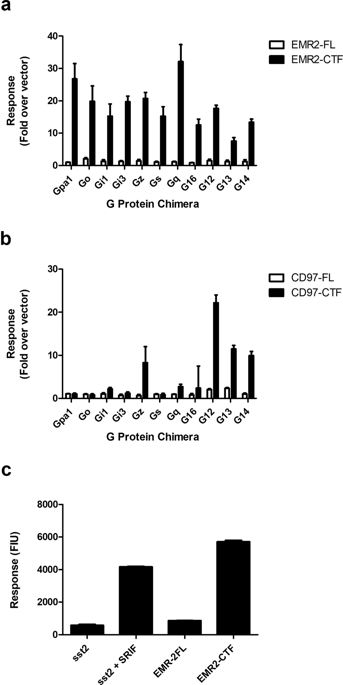Our official English website, www.x-mol.net, welcomes your
feedback! (Note: you will need to create a separate account there.)
G Protein-Coupling of Adhesion GPCRs ADGRE2/EMR2 and ADGRE5/CD97, and Activation of G Protein Signalling by an Anti-EMR2 Antibody.
Scientific Reports ( IF 3.8 ) Pub Date : 2020-01-22 , DOI: 10.1038/s41598-020-57989-6 Nisha Bhudia 1 , Sapna Desai 1 , Natalie King 2 , Nicolas Ancellin 3 , Didier Grillot 3 , Ashley A Barnes 4 , Simon J Dowell 1
Scientific Reports ( IF 3.8 ) Pub Date : 2020-01-22 , DOI: 10.1038/s41598-020-57989-6 Nisha Bhudia 1 , Sapna Desai 1 , Natalie King 2 , Nicolas Ancellin 3 , Didier Grillot 3 , Ashley A Barnes 4 , Simon J Dowell 1
Affiliation

|
The experimental evidence that Adhesion G Protein-Coupled Receptors (aGPCRs) functionally couple to heterotrimeric G proteins has been emerging in incremental steps, but attributing biological significance to their G protein signalling function still presents a major challenge. Here, utilising activated truncated forms of the receptors, we show that ADGRE2/EMR2 and ADGRE5/CD97 are G protein-coupled in a variety of recombinant systems. In a yeast-based assay, where heterologous GPCRs are coupled to chimeric G proteins, EMR2 showed broad G protein-coupling, whereas CD97 coupled more specifically to Gα12, Gα13, Gα14 and Gαz chimeras. Both receptors induced pertussis-toxin (PTX) insensitive inhibition of cyclic AMP (cAMP) levels in mammalian cells, suggesting coupling to Gαz. EMR2 was shown to signal via Gα16, and via a Gα16/Gαz chimera, to stimulate IP1 accumulation. Finally, using an NFAT reporter assay, we identified a polyclonal antibody that activates EMR2 G protein signalling in vitro. Our results highlight the potential for the development of soluble agonists to understand further the biological effects and therapeutic opportunities for ADGRE receptor-mediated G protein signalling.
中文翻译:

粘附GPCR ADGRE2 / EMR2和ADGRE5 / CD97的G蛋白偶联,以及抗EMCR2抗体对G蛋白信号的激活。
粘附性G蛋白偶联受体(aGPCR)在功能上与异源三聚体G蛋白偶联的实验证据已经逐步出现,但将生物学意义归因于其G蛋白信号传导功能仍然是一项重大挑战。在这里,利用受体的活化的截短形式,我们表明ADGRE2 / EMR2和ADGRE5 / CD97在多种重组系统中都与G蛋白偶联。在基于酵母的分析中,异源GPCR与嵌合G蛋白偶联,EMR2显示广泛的G蛋白偶联,而CD97更具体地与Gα12,Gα13,Gα14和Gαz嵌合体偶联。两种受体均诱导百日咳毒素(PTX)对哺乳动物细胞中环AMP(cAMP)水平的不敏感抑制,表明与Gαz偶联。EMR2已显示通过Gα16和Gα16/Gαz嵌合体发出信号,刺激IP1的积累。最后,使用NFAT报告基因检测,我们鉴定了一种在体外激活EMR2 G蛋白信号的多克隆抗体。我们的结果突出了开发可溶性激动剂的潜力,以进一步了解ADGRE受体介导的G蛋白信号传导的生物学效应和治疗机会。
更新日期:2020-01-23
中文翻译:

粘附GPCR ADGRE2 / EMR2和ADGRE5 / CD97的G蛋白偶联,以及抗EMCR2抗体对G蛋白信号的激活。
粘附性G蛋白偶联受体(aGPCR)在功能上与异源三聚体G蛋白偶联的实验证据已经逐步出现,但将生物学意义归因于其G蛋白信号传导功能仍然是一项重大挑战。在这里,利用受体的活化的截短形式,我们表明ADGRE2 / EMR2和ADGRE5 / CD97在多种重组系统中都与G蛋白偶联。在基于酵母的分析中,异源GPCR与嵌合G蛋白偶联,EMR2显示广泛的G蛋白偶联,而CD97更具体地与Gα12,Gα13,Gα14和Gαz嵌合体偶联。两种受体均诱导百日咳毒素(PTX)对哺乳动物细胞中环AMP(cAMP)水平的不敏感抑制,表明与Gαz偶联。EMR2已显示通过Gα16和Gα16/Gαz嵌合体发出信号,刺激IP1的积累。最后,使用NFAT报告基因检测,我们鉴定了一种在体外激活EMR2 G蛋白信号的多克隆抗体。我们的结果突出了开发可溶性激动剂的潜力,以进一步了解ADGRE受体介导的G蛋白信号传导的生物学效应和治疗机会。


















































 京公网安备 11010802027423号
京公网安备 11010802027423号